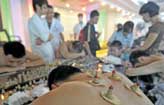Technology
More work needed on healthcare reform
Updated: 2011-07-29 12:54
By Li Ling (China Daily European Weekly)
Two years after the Chinese government announced guidelines for healthcare reform, a number of new regulations are now in place, demonstrating the potential for reform. However, more focus should be given to clarifying goals of the overall reform to fix the remaining issues in the healthcare system.
According to the guidelines, the government is required to establish a medical care system for all Chinese residents between 2009 and 2011. The reform has addressed many issues, but the healthcare system continues to be plagued by multiple problems.
China established a healthcare insurance system for urban workers, farmers and residents in less than 10 years. The system, together with urban and rural medial assistance, gives all citizens some form of healthcare coverage. This is the first time in decades the government has taken this type of action.
About 835 million people, which accounts for 95 percent of rural residents, have joined the New Rural Cooperative Medical System, created in 2003.
Many American scholars are surprised and envious at the speed of China's public healthcare system reform as the United States government is still struggling with how to implement a public healthcare insurance option. US President Barack Obama's healthcare reform bill is currently under legal review.
China has strengthened public health, launched preventative health measures aimed at women and created more awareness about hypertension. The government also established the National Essential Medicines Policy, designed to oversee the production and delivery of medicine. From a historical point of view, this is a major milestone for the Chinese government to achieve these goals.
Two-thirds of rural clinics were in disrepair about 10 years ago. Farmers and urban residents were not covered by healthcare insurance, so it was normal for people with serious illnesses to receive no treatment or to spend all of their savings to pay for medical bills.
At that time, patients had to pay for almost 60 percent of their medical bills, compared with the 30 percent they pay now. Few were able to take advantage of the limited healthcare coverage offered by the government. The equality of the healthcare system ranked fourth from bottom in the world.
Overall reform still lags
During the two-year process, various government departments were able to broaden insurance coverage, raise the monthly payments of every person, increase the government's investment in healthcare and establish the National Essential Medicines Policy. By uniting together, the departments will be able to address tougher issues.
Reforms led by medical departments were achieved quickly. But alterations relating to other departments, such as financial investment, budgets, human resources, executive management and performance assessment, did not change that much. This is a barrier to healthcare reform.
The government, in the long term, should consider adjusting the structure of the system to: control medical costs, optimize how medicine and medical supplies are distributed, lower medical prices for patients and balance the number of treatment facilities. These suggestions are more difficult to accomplish, but the longer the government waits, the harder it will be for it to resolve these issues.
The lack of clarification can often delay issues that can haunt the healthcare system for a long period of time. For example, the problem of increasing hospital revenue by excessive prescription and drug sales was discussed for years, but it was not solved until now. Why?
Hospitals must also get a clarification on how they can generate revenue. The guidelines offer three ways: increasing treatment costs, investing more in medical insurance and raising the amount financed by government. Three departments, the National Development and Reform Commission, the Ministry of Human Resources and Social Security, and the Ministry of Finance, are responsible for implementing these ideas. The guidelines were not specific on how these departments can work together to make this reform successful.
Even though the problem mentioned above is solved, how to compensate doctors is another problem. If the financial ministry is paying the salary of a doctor, how will this doctor be evaluated? How are hospital presidents assessed? These are relevant questions that will help the human resources department and develop performance assessments.
After solving those problems, how do medical factories and staff of pharmaceutical distribution process survive? How is equality ensured in the bidding process? These questions are related to many sections of medical production, distribution and usage.
East China's Anhui province proved that with a successful implementation of the National Essential Medicines Policy, hospitals are able to increase revenue without excessive prescription.
Therefore, the next step should focus on overall reform. Not only design a suitable stimulation system to spur change in the healthcare departments, but also ensure that other sections truly realize overall reform. The key to reaching the goal is to adjust the administrative management system.

Specials

Wen pledges 'open' probe
Design flaws in the signal equipment led to Saturday's fatal high-speed train collision, authorities say.

Turning up the heat
Traditional Chinese medicine using moxa, or mugwort herb, is once again becoming fashionable

Ciao, Yao
Yao Ming announced his retirement from basketball, staging an emotional end to a glorious career.